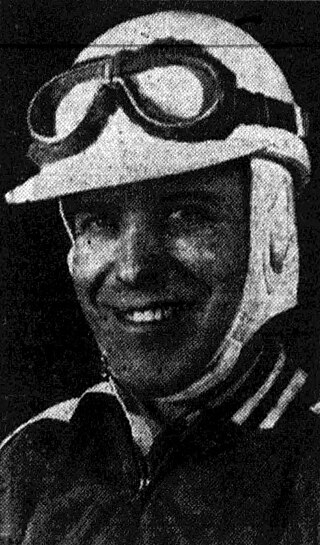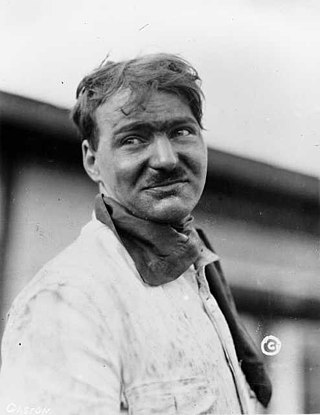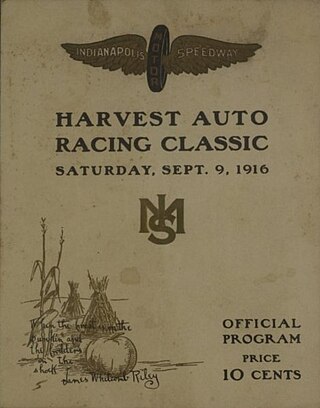
Melvin Eugene "Tony" Bettenhausen was an American racing driver known primarily for his open-wheel career. He twice won the National Championship, doing so in 1951 and 1958. He also competed in stock cars, winning under AAA and USAC sanction.

Gaston Louis Chevrolet was an American racing driver and automobile manufacturer. He was the winner of both the Indianapolis 500 and the American National Championship in 1920.
The 1915 Grand Prix season saw Grand Prix motor racing continue in the United States. Racing was suspended in Europe due to the outbreak of World War I. The American Grand Prize was held in San Francisco for the first time, in conjunction with the Panama–Pacific International Exposition. Several of the latest European cars had been imported to the USA before the war started. Briton Dario Resta had a Peugeot and Ralph DePalma raced one of the Mercedes GPs. While Resta won both races at San Francisco and DePalma won the Indianapolis 500, just ahead of Resta it was Earl Cooper, running a Stutz, whose consistency gave him the unofficial AAA national championship.
The 1916 Grand Prix season saw Grand Prix motor racing continue in the United States. Racing was suspended in Europe due to the World War I engulfing the continent. Once again European cars dominated Indianapolis with victory going to Briton Dario Resta in a Peugeot. With the organisers wanting to appeal to the spectators, this was the only year that the race was scheduled for a shorter length – to run only 300 miles. The Vanderbilt Cup and the American Grand Prize returned to Santa Monica, California, at the end of the year. Resta repeated his victory from the year before, winning the Vanderbilt Cup. Then when he retired in the Grand Prize it was Howdy Wilcox and Johnny Aitken who won in another of the dominant Peugeots. Oval courses now dominated the AAA Championship with these two events being the only road-course races this year. It proved to be the final time these two formative American races were held in this format; while racing in America continued throughout the First World War, public interest had shifted away from road racing.

The Wheeler-Schebler Trophy Race was an automobile race held at the Indianapolis Motor Speedway in each of the two years prior to the first Indianapolis 500. The trophy was sponsored by the Wheeler-Schebler Carburetor Company. Frank Wheeler, one of the four co-founders of the Speedway, was also the president and co-founder of Wheeler-Schebler. The 1909 race was originally scheduled for 300 miles, but was ended at 235 miles due to deteriorating track conditions.

The Harvest Auto Racing Classic was a series of three automobile races held at the Indianapolis Motor Speedway on Saturday September 9, 1916. The meet, held four months after the 1916 Indianapolis 500, featured a 20-mile race, a 50-mile race, and a 100-mile race. The main event, a 100-mile Championship Car race, paid points towards the 1916 AAA National Championship. Johnny Aitken won all three races, two of which had a margin of victory of less than a car length.
The 1919 Grand Prix season was the first season following the armistice that ended World War I in November 1918. European economies were struggling, and many automotive firms had to recover and retool from military production. So, there was very little racing activity as it took time for the companies and populations to recover. As the world rebuilt there were only two major races held in the year – the Indianapolis 500 and the Targa Florio.
The 1909 AAA Championship Car season consisted of 24 races, beginning in Portland, Oregon on June 12 and concluding with a point-to-point race from Los Angeles, California to Phoenix, Arizona on November 6. There were three events sanctioned by the Automobile Club of America in Lowell, Massachusetts. AAA did not award points towards a National Championship during the 1909 season, and did not declare a National Champion.
The 1910 AAA Championship Car season consisted of 19 races, beginning in Atlanta, Georgia on May 5 and concluding in Long Island, New York on October 1. AAA did not award points towards a National Championship during the 1910 season, and did not declare a National Champion.

The 1911 AAA Championship Car season consisted of 21 races, beginning in Oakland, California on February 22 and concluding in Savannah, Georgia on November 30. AAA did not award points towards a National Championship during the 1911 season, and did not declare a National Champion. Ray Harroun was the winner of the inaugural Indianapolis 500.
The AAA Contest Board was the motorsports arm of the American Automobile Association. The contest board sanctioned automobile races from 1904 until 1955, establishing American Championship car racing. Modern-day Indy car racing traces its roots directly to these AAA events.
The 1920 AAA Championship Car season consisted of 5 races, beginning in Beverly Hills, California on February 28 and concluding in Beverly Hills on November 25. The AAA National Champion and Indianapolis 500 champion was Gaston Chevrolet. The 1920 season later became a source of confusion and misinformation for historians when in 1926 the AAA published a revisionist history, naming another driver as the season's point champion.
The 1923 AAA Championship Car season consisted of 8 races, beginning at Beverly Hills, California on February 25, 1923, and concluding at the same location on November 29, 1923. The AAA National Champion was Eddie Hearne, and the Indianapolis 500 winner was Tommy Milton.
The 1912 AAA Championship Car season consisted of 18 races, beginning in Santa Monica, California on May 4 and concluding in Brooklyn, New York on November 5. There was also one non-championship event at Milwaukee, Wisconsin. AAA did not award points towards a National Championship during the 1912 season, and did not declare a National Champion. Joe Dawson was the winner of the Indianapolis 500.
The 1913 AAA Championship Car season consisted of 14 races, beginning in San Diego, California on January 1 and concluding in Corona, California on September 9. AAA did not award points towards a National Championship during the 1913 season, and did not declare a National Champion. Jules Goux was the winner of the Indianapolis 500.
The 1914 AAA Championship Car season consisted of 15 races, beginning in Santa Monica, California on February 26 and concluding in Corona, California on November 26. AAA did not award points towards a National Championship during the 1914 season, and did not declare a National Champion. René Thomas was the winner of the Indianapolis 500.
The 1915 AAA Championship Car season consisted of 27 races, beginning in San Diego, California on January 9 and concluding in San Francisco, California on November 25. AAA did not award points towards a National Championship during the 1915 season, and did not declare a National Champion. Ralph DePalma was the winner of the Indianapolis 500.

The 1917 AAA Championship Car season consisted of 21 races, beginning in Los Angeles, California on March 4 and concluding there on November 29. AAA did not award points towards a National Championship during the 1917 season, and did not declare a National Champion.
The 1918 AAA Championship Car season consisted of 16 races, beginning in Uniontown, Pennsylvania on May 16 and concluding there on September 2. There were also 3 non-championship races. AAA did not award points towards a National Championship during the 1918 season, and did not declare a National Champion.





